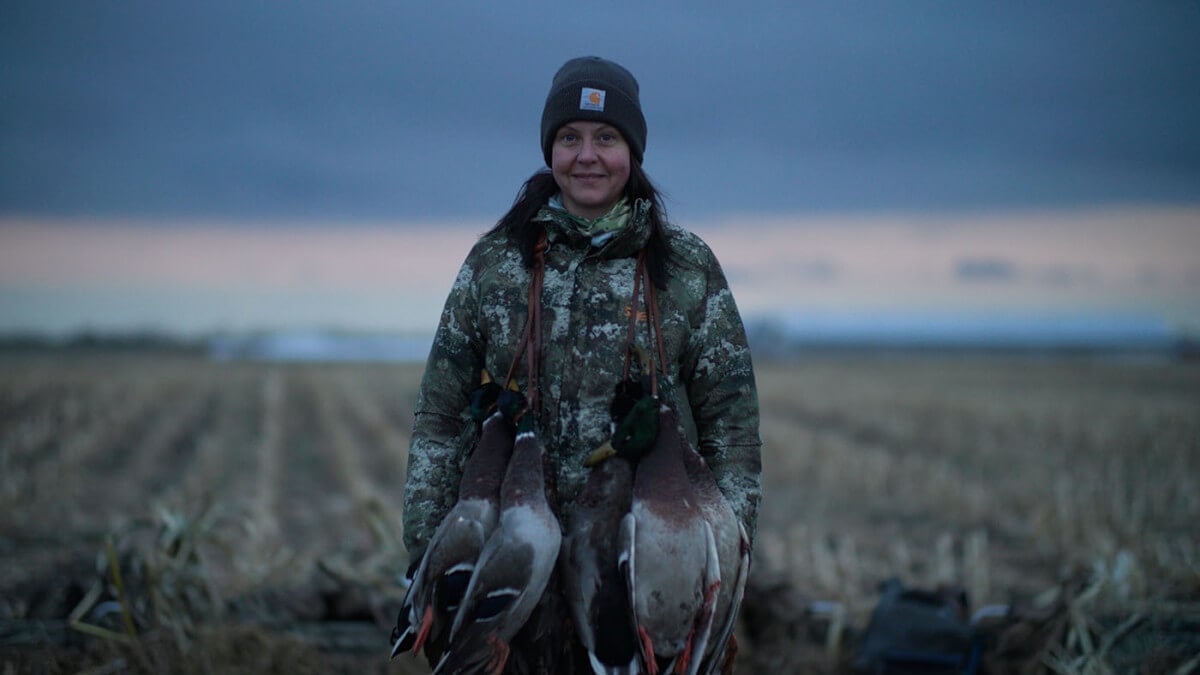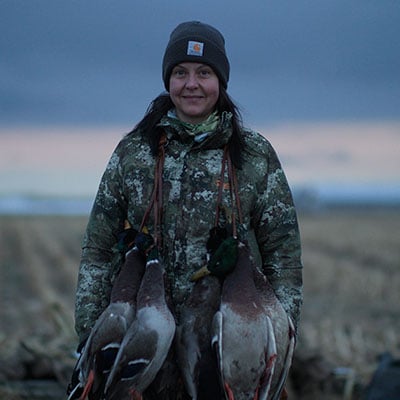- Savage Blog
- Under Wing: Hunting for Conservation and Sustainability
Under Wing: Hunting for Conservation and Sustainability

A smile of recognition breaks across my face, hearing my friend Courtney’s bubbly voice on the other end of the line. Her quirky personality and fun sense of humor make our friendship feel easy, light and refreshing. Excitedly, she asks if I’m interested in attending a Savage Arms sponsored hunt in Canada with her. Before she finishes, I exclaim, “YES!”, thrilled at the opportunity.
Courtney’s been an instrumental part of my journey into waterfowl hunting, where she’s graciously counseled and mentored me—even though we live multiple states apart. We met a few years back at a big game hunt camp in Montana with a group of remarkable women and soon becoming fast friends. Sharing my interest and desire to pursue waterfowl hunting, I explain my struggle in finding a mentor, locations to hunt, and (at the time) my lack of knowledge with shotguns.

Growing up in Alaska, raised in an active hunting and fishing family, notably accented by commercial fishing and my father’s passion for big game hunting, one could certainly say “it’s in my blood”. Occasionally, tagging along on these hunts, I learned through immersion. Although more often than not my role involved processing the meat he brought home. Nurturing the connection between nature, conservation, subsistence and family was an instrumental part of my upbringing. Moose, caribou, and salmon filled our freezers.
My parents always demonstrated a love and respect for the environment and the resources it offers us. A sustainability focused mindset continues to influence my daily life, embracing the belief that our duty is to conserve natural resources and foster a sense of stewardship for generations to come. Feeling I have an opportunity to care for the planet in a way that promotes regeneration and cultural connection. These values were instilled at a young age and have sustained me throughout life.
Ultimately, we moved from Alaska to Washington state, due to a toxic tanker car chemical spill that fundamentally altered our health. Life changed drastically during this transition, including more limited hunting opportunities and adjustments for increased travel time needed to access and successfully hunt big game. The resulting loss invariably ended with our freezers not being filled with wild game. These changes significantly influenced my decision to begin farming and raising my own meat for food security and avoid corporate farming. Being part of the process and connected to the things I eat are an imperative part of my being.

This leads me back to waterfowl hunting. Living in an area where travel is necessary to hunt birds, limits the available opportunities for providing this valuable resource. Additionally, hunting without a guide means more knowledge, time, skill, practice, and scouting in order to successfully hunt public lands. Consequently, accepting this offer from Courtney and Savage thrust me into a whole new world of excitement and opportunity. Fully invested in preparing for the hunt and becoming familiar with this firearm, I traveled to Oregon state to work with an accomplished female shooting instructor I’d previously met through mutual friends. The semi-automatic Renegauge features almost zero recoil and excellent customization. The exposure, experience and confidence gained, gave me the tools needed for the next leg of this journey.
It was apparent when Courtney, Olivia, Allison, and I met in Colorado for our flight to Canada, that this group of women were about to have an epic adventure together. The energy and excitement we shared inspired us all. Upon arriving at the hunting lodge that evening we were greeted by the owners and guides of Ole Dog Outfitters- a group of four guys, whose passion and love for waterfowl hunting was evident. Albeit they couldn’t hide their surprise of an all-female group; followed with a smidge of reservation and uncertainty in their eyes. We ate dinner, laughed, shared our history in hunting and made plans for our first morning’s hunt.
It was cold and clear when we arrived at the hunting location- a freshly cut wheat field, filled with over a hundred snow goose decoys—all strategically placed in front of our layout chairs. The smiles and excitement were contagious. The guides provided instructions, tips, and bag limits as we prepared for the quickly approaching shooting light. There were a lot of moving pieces to remember amidst the advancing time. We practiced repeatedly popping up from our chairs and shouldering our shotguns, trying to perfect the smooth and concise actions needed to be stealthy and successful. My mind simultaneously reminded me to pick a bird, don’t stop swinging, and follow through with your shot. Calling the birds in just before legal shooting light, showed us the impressive expertise and wisdom our guides provided. The sky above us filled with hundreds of birds, a spectacular sight. As the light crept across the horizon, we were told to prepare to shoot. My eyes fixed on the sky above as the flock of birds approached the decoys. We all laid quietly in our layout chairs, perfectly camouflaged in our all-white jumpsuits. Startled from a focused trance, I heard from behind me, “Shoot!”. Quickly popping up from my layout, choosing a bird and pulling the trigger- the shot felt rushed and yet I watched as the chosen bird fell from the sky, laying close to the others taken in this wave. Beginner’s luck, I surmise—I’ll take it. The smell of gun smoke wafted through the morning air, followed by an eruption of cheers and high fives.

The dogs were sent to retrieve our birds, and the guides collectively congratulated us, sharing in our excitement. Admittedly, their hesitancy on our success due to the uncertainty of an all-women’s group- later subdued, as one calls out, “Holy crap, you girls can shoot!” We were elated to show our tenacity and ability as a group of female hunters, some of whom, including myself, are new to waterfowl hunting. Our mentors, Courtney & Allison had absolute faith that we would all be successful.
With the birds collected and placed behind us, we rapidly regrouped, as the next flock quickly flew towards us. Mesmerized by the sounds, colors and number of ducks and geese flying overhead, the distraction level was high, sometimes resulting in missed opportunities or not enough time to reload between shots. The learning curve that morning provided immense knowledge and guidance. Everything practiced over the months leading up to this hunt truly paid off and each day and new location progressed like the next filled with success, gratitude, perspective, and opportunity to test out my skills and equipment—resulting in learning more with each shot taken. Patterns, sounds and lessons provided the insight and wisdom gained only through comradery and irreplaceable experiences.
Being a person who finds hunting and conservation incredibly important, I dove further into the specifics of waterfowl hunting in Canada. Bag limits of 50 geese per day led me to learn, as suspected, that the overpopulation of these animals leads to vast and devastating damage on tundra and freshwater marshes. Waterfowl hunting is an important tool in population management to help sustain a balanced ecosystem. Effective management efforts such as those provided by this opportunity with Savage Arms and other conservation organizations provides insight and encouraging progress in the desire to conserve ecosystems for generations to come.

I feel fortunate to have had the opportunity to hunt with other conservation enthusiasts in an active and invested community, committed to a sustainable future. Like in the US, by purchasing a Canadian Wildlife Habitat Conservation Stamp and a Migratory Game Bird Permit, you support wildlife management and habitat conservation. Our contribution helps to ensure that the intrinsic value of wildlife remains present. Ecosystem based population management is an important tool for encouraging healthy natural resource longevity while also promoting education, teamwork, collaboration, and stewardship.
As this chapter ends the overwhelming feeling is that of gratitude, humility, and inspiration. The desire to continue pursuing conservation and hunting management grows daily. Thank you, Savage Arms, for nurturing this adventure, providing a stellar firearm, and encouraging the hunting community to step beyond your limiting beliefs and into the unknown. You never know, you might end up in Canada, hunting snow geese with a phenomenal group of women in some of the most stunning country on the planet.

